The story of the Waters family in Bedfordshire begins with Newtonbury Farm, Dunton, Bedfordshire, England. In the early 1800s, the Waters family took over Newton Bury Farm, just outside the rural village of Dunton. Today there are many descendants across the world.
Thomas Waters 1829-1913
I introduced Thomas Waters in a previous series of posts that were transcriptions of letters that he wrote home to his family in Bedfordshire. The story of the Waters family at Newton Bury Farm begins with Thomas Waters father, Thomas Waters Snr. 1
Before the Waters Family Arrived
Newton Bury Farm started out as a large estate named Chamberlain’s Bury, belonging to the Chamberlain family, who were landowners in the area as early as 1210. At some time, a piece of land was sectioned off and became Newton Bury Farm. The Chamberlain family married into the Spencer Family, who still own the original Chamberlain farm today. You may recognise the Spencer family as being the family of Princess Diana, the first wife of King Charles of England.
Chamberlain Farm was mentioned in the Domesday book in 1210:
Chamberlain Farm, also known as Chamberlain's Bury, is a historic farm located in Dunton, Bedfordshire, England. The name "Chamberlain" is derived from the Chamberlain family, who held land in the area as early as 1210. The farm has been associated with various agricultural activities over the centuries. For instance, in 1677, a lease was granted for a farmhouse called Newton Bury (also known as Chamberlain's Bury) in Dunton, indicating its continued use as a working farm during that period.2
A page from the Domesday book - https://opendomesday.org/
Newton Bury Farm, is a site of considerable archaeological and historical interest. At its heart lies a medieval moated enclosure, now a Scheduled Monument protected by Historic England. Walking the nearby public footpaths today, you can still trace the outlines of the moat, dry in some places and deeply sunken in others.
“The moated site at Newton Bury is a well-preserved example of a small, double- island type which retains evidence of the water management system. Despite alterations to the monument, particularly the infilling of sections of the ditches and the later use of the moated enclosures as a farm, the major part of the site has survived with minimal disturbance. Environmental evidence will be preserved in the silts within the ditches, and the islands will contain evidence of the original buildings. The monument lies in an area where moated sites are particularly numerous enabling chronological and social variations to be explored. The existence of historical records relating to the ownership of the site further enhances its importance”.3
The moated site dates back to the Middle Ages, with the main enclosure measuring about 90 meters by 80 meters. The moat itself was enlarged at two corners to create ponds, probably used in later centuries for watering livestock, a hint of how this land evolved over time to meet the needs of those who lived and worked there. Within the moated area stood Newton Bury farmhouse, and the surrounding earthworks still hint at additional outbuildings, a well, and long-forgotten boundaries.
By the 19th century, when the Waters family came to own Newton Bury Farm, it had already been an established agricultural estate for hundreds of years. An 1896 report and valuation, now held at the Bedfordshire Archives, describes it as a “conveniently situated” and “tithe-free” property, just half a mile from Dunton village. It was accessible to nearby towns and railway stations, crucial for access to expanding markets.
Today, while the farm itself remains privately owned and not accessible to the public, it can still be admired from the public footpaths that wind through the Bedfordshire countryside. Impressions of the moat, can be seen in the grass, dry and in some places and deeply sunken in others. The house was occupied until the 1940s and demolished in 1963, however there are ruins of outbuildings still standing. Walking the nearby public footpaths today, you can still trace the outlines of the moat, dry in some places and deeply sunken in others.
About Newton Bury Farm
Newton Bury Farm was situated 8 miles from Biggleswade, on the Great Northern Main Road, and 3 miles from Potton, on the Bletchley and Cambridge branch of the London and North Western Railway. The Newton Bury farm homestead was a 17th century farmhouse, timber framed with external plastering.
The first mention I found of Newton Bury Farm, came from an entry in the Bedfordshire Archives.4 Thomas Waters is my 3x great grandfather. He married Ann IZZARD, and they raised a large family at Newton Bury Farm.
Thomas Waters is shown on 09 June 1838, as being the holder of 173 acres 0Roods and 38 Perches of land. Of the 24 landholders in the Parish of Dunton he was the 7th largest, the Parish consisting of 2548acres, 2Roods and 8Perches. - Survey of Farms and Land in the Parish of Dunton, Bedfordshire , prepared by Catlin Johnson, Land Measurer
Description of Newton Bury Farm:
"Market Gardening Farm", consisting of 170 acres 3Roods 33Poles, of "rich arable land, in a high state of cultivation and old pasture with old-fashioned moated house, surrounded by prettily timbered meadows and orchards"5 (Source: Beds C.R.O. RR15/37[JonesTaylorCalnan.GED]
The following images are For Sale advertisements for Newton Bury Farm in 1909. The farm was not owned by the Waters family at the time, but it gives very detailed information about the farm. 6
Researching my family history has led me down many unexpected pathways, but few as interesting and historical as Newton Bury Farm. This land, once owned by my ancestors is a link to centuries of English rural life, and also a link to my family today.
Bedfordshire Archives Newton Bury Farm
Historic England Newton Bury Farm
Bedfordshire Archives, C.R.O. D. DP51/28/1
Bedfordshire Archives, C.R.O. RR15/37
For Sale Posters: Bedfordshire Archives




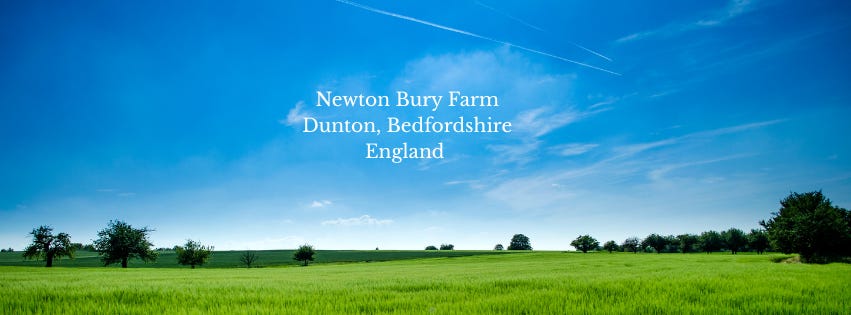
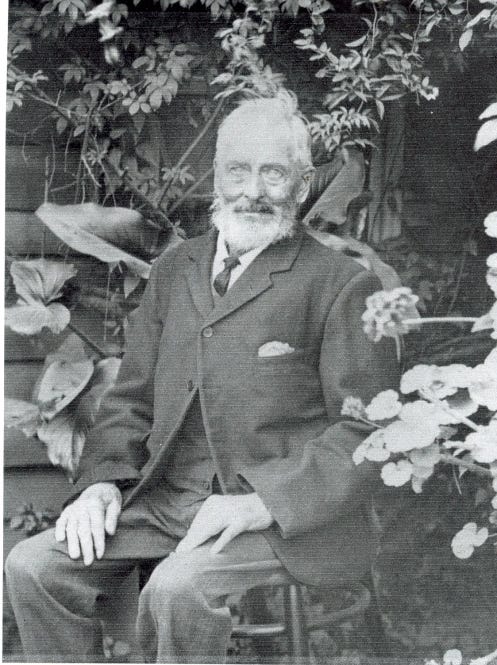
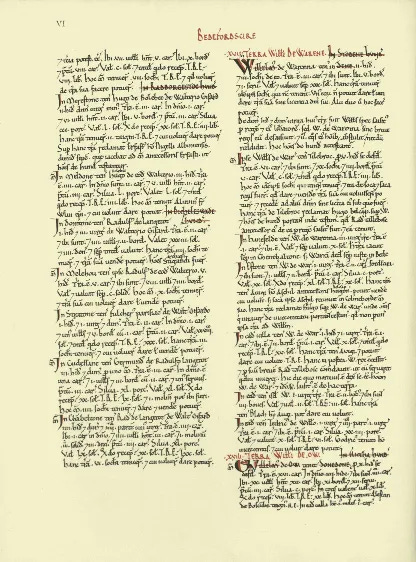

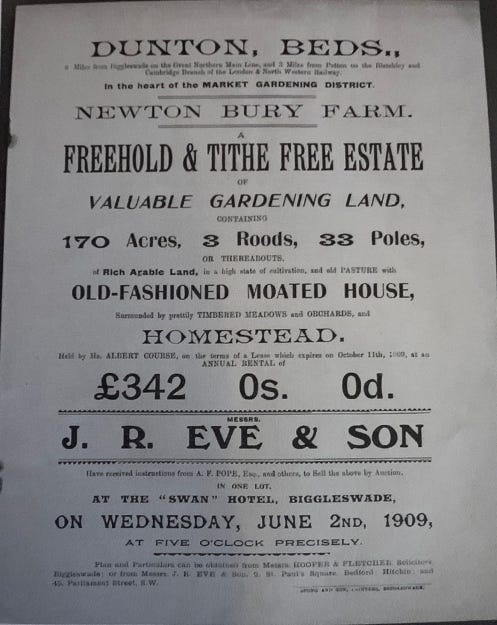
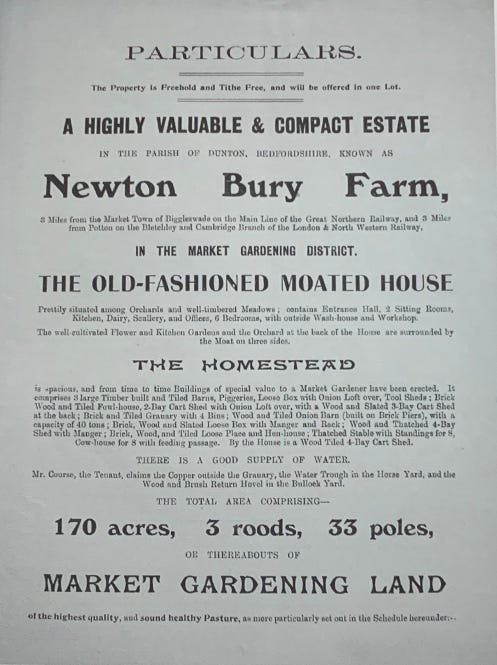

Another fascinating story about your family. I enjoy seeing all the historical connections.
I feel like I have gotten to know Thomas Waters quite well through your earlier posts, Jennifer, so it is interesting to hear more about where he came from and about others who lived there. I was at Biggleswade last May. I wonder if I travelled anywhere near Newton Bury Farm getting there?